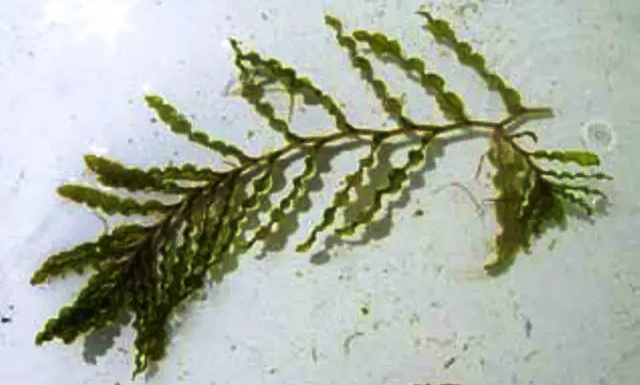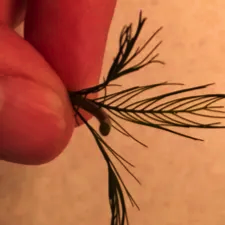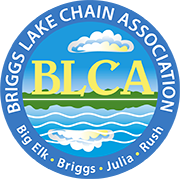Please also see:
- Aquatic Invasive Species (AIS)
- Aquatic Invasive Animals (Golden Clam, Zebra Mussels, Carp)
- Invasive and Harmful Species
Vegetative Management Plans
Below are overall plans to help control instances of nuisance plants and Aquatic Invasive Species that impair lake usage in the Briggs Lake Chain.
Curly-leaf Pondweed (CLP)
For DNR curly-leaf identification, please see: https://www.dnr.state.mn.us/invasives/aquaticplants/curlyleaf_pondweed.html
Curly-leaf sprouts in the fall and grows over winter limited only by how much sunlight is blocked by the ice. When the ice goes out in early spring, curly-leaf grows fast, forming dense mats blocking sunlight to native plants which have not yet started to grow. In this way curly-leaf out-competes and displaces the native plants.

Curly-leaf Pondweed (Rush Lake 2018).
Biomass in curly-leaf stands is often much greater than in native aquatic stands which can impair recreational use of lakes and displace native aquatics.
Curly-leaf decays in early summer (around July 4th), which releases its larger biomass (nutrients) into the water increasing algae blooms and degrading water quality. This decay allows the buds (turions) to become detached and spread planting themselves in the sediment. During the decay sufficient levels of nutrients can occur making some areas devoid of oxygen. Low oxygen can cause fish kills and foster blue green algae growth (unsafe for dogs). Lack of oxygen can also lead to chemical reactions resulting in once-sequestered phosphorus being released from sediment.
It is important that any control of curly-leaf pondweed not damage native plants, but rather maintain or increase their abundance. Abundant and diverse native aquatic communities host a variety of helpful organisms. A diverse aquatic plant community can help sustain water clarity by providing a refuge for zooplankton (food for fish), sequestering nutrients (phosphorus for example), reducing sediment resuspension (muddy water), and decreasing algae abundance.
Treatment chemicals = Aquathol K (> 3 ppm used in 2022 with reduced areas due to flowing water. See water stabilization graph for times.
Maps of the surveys used for spraying of Curly-Leaf Pondweed.
(2020 updated is to meet DNR max allowed requirements)
For previous years’ maps, please see AIS Archives.
Eurasian Watermilfoil (EWM)
This aquatic invasive is a submerged plant with feather-like leaves. It often spreads through fragments rather than seed, and so can easily be spread by boat. It forms dense mats and inhibits recreation and is poor for shelter, food and nesting habitat for native animals.
In 2013, EWM was found in Rush lake. It was aggressively treated & hand-pulled in 2014, through 2019. A survey in 2019 found only one plant. Surveys in years since did not find any in this lake. Surveys will continue until a full five years have passed to have it considered eradicated by the DNR. Current 2023 Survey found no EWM in Rush! It’s been 5 years!
Treatment chemicals for Rush was 2,4-D targeting 2.0 ppm
For Eurasian Watermilfoil identification, please see: https://www.dnr.state.mn.us/invasives/aquaticplants/milfoil/index.html


Eurasian Watermilfoil (Rush Lake 2014)
September 2020 EWM was found in the south end of Big Elk Lake. It too, was aggressively hand-pulled by volunteers. A survey conducted in July of 2021 showed an increase in the number of plants and Big Elk was chemically treated in August. Treatment chemicals for Elk used ProcellaCOR and diquat dibromide.
June 2023 Elk EWM survey shows No plants. Lets hope next years will be the same!
Area residents are encouraged to learn how to identify this invader and keep a watchful eye out for plants that should be removed quickly.
For previous years’ maps, please see AIS Archives.

